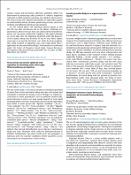Options
Aerobic granular sludge in a sequencing batch reactor
Date issued
2015
Author(s)
Ionescu, Ioana
Bumbac, Costel
Cornea, Petruta Calina
Abstract
Granular sludge consist of bacterial aggregates that are much more compact than traditional activated sludge, thus offering numerous advantages such as high biomass retention, good settling ability and simultaneous removal of organic load and nutrients. In a laboratory scale sequencing batch reactor (SBR) granules were cultured under aerobic conditions. To enhance the growth of granular sludge the SBR was operated with very short sedimentation and draw phases resulting in the washout of slow settling biomass (anaerobic feeding – 45 min, aerobic reaction – 11 h, settling – 5 min and effluent withdrawal – 10 min). The reactor was inoculated with conventional activated sludge and fed with dairy industry wastewater with high organic and nutrients load. The
first aerobic granular structures, having 67–556 m in diameter, were observed after 5 days. After 25 days, they reached diameters between 513 m and 1276 m and increased gradually up to diameters of 2 mm by the end of the experiment. Treatment performances increased along with the growth of granules size.
first aerobic granular structures, having 67–556 m in diameter, were observed after 5 days. After 25 days, they reached diameters between 513 m and 1276 m and increased gradually up to diameters of 2 mm by the end of the experiment. Treatment performances increased along with the growth of granules size.
Files
Loading...
Name
aerobic granular sludge, Ioana Ionescu.pdf
Size
53.52 KB
Format
Adobe PDF
Checksum
(MD5):5ff7660e97c7b966f345a7709eed5630